We have found that one of the key things for uneventful air travel is understanding the rules and restrictions for packing personal items. Aidan is usually the one who does the research but I really appreciate how much less stressful it is when you can be confident that you have packed everything in the right place before going through customs. One category of items that often raises questions is aerosols. Aerosols include things like deodorants, hair sprays, and certain medicinal products, and they are typically housed in pressurized cans.
We were curious as to why there are restrictions for bringing aerosols on planes in pretty much every country around the world. The main concern is that there is a small chance aerosols could explode on a plane. Because aerosols are pressurized containers extreme change in heat and pressure could cause them to explode. The good news is that while there are some fluctuations in temperature and air pressure during flights, they are not usually big enough to cause aerosols to explode. However, to be on the safe side, aerosols containing flammable liquids are not allowed on planes.
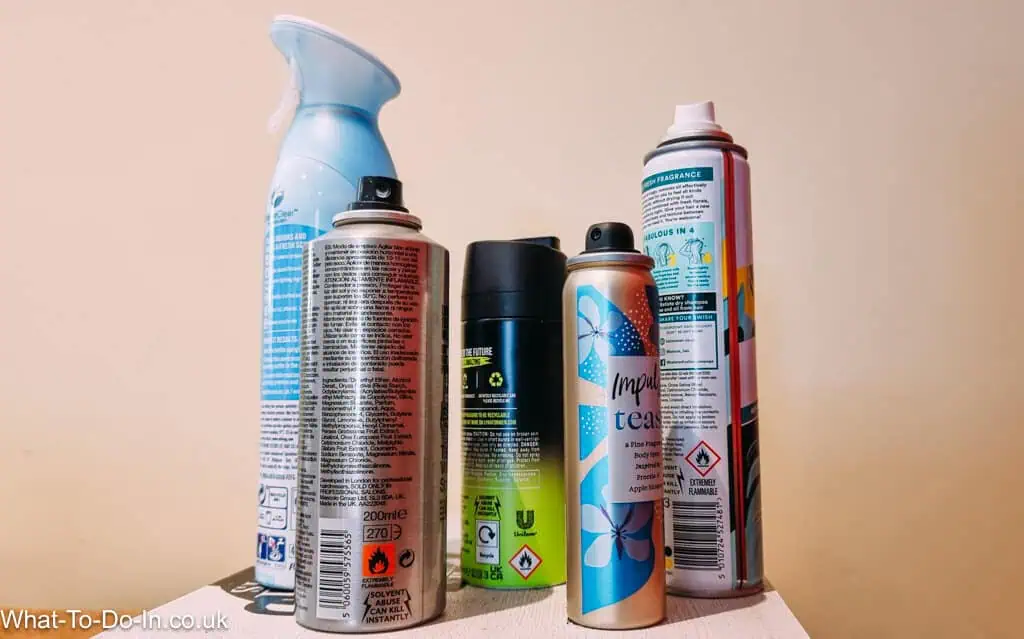
Specific rules apply to bringing aerosols onto a plane. These rules, set by authorities such as the Transportation Security Administration (TSA) in the U.S. or the International Air Transport Association (IATA) for international flights, aim to ensure the safety of all passengers and the aircraft. From size and quantity limits to packing guidelines, familiarizing yourself with these regulations can help ensure a smooth, hassle-free journey.
Aerosols on USA Domestic Flights
According to the Transportation Security Administration (TSA), aerosols are subject to certain restrictions and conditions when carried on flights within the United States. These rules are designed to prevent accidents related to pressure changes or potential flammability.
- Carry-On Luggage: Aerosols that are classified as toiletries for personal care or medicinal purposes are allowed in carry-on baggage. These must be 3.4 ounces (100 ml) or less and should fit in a one-quart-sized, clear plastic, zip-top bag.
- Checked Luggage: Aerosols in checked luggage are allowed, as long as they are not classified as hazardous materials. The overall limit is 70 ounces (2 liters) per passenger.
- Exceptions: Certain aerosols such as bear repellents, pepper sprays, and tear gas are strictly prohibited from both carry-on and checked luggage.
Toiletries – https://www.tsa.gov/travel/security-screening/whatcanibring/items/deodorant-aerosol
Flammable Aerosol – https://www.tsa.gov/travel/security-screening/whatcanibring/items/flammable-liquid-gel-or-aerosol-paint
Flying with Aerosols Internationally
The general rules and regulations about carrying aerosols on international flights are similar to the TSA.
International Air Transport Association (IATA) Guidelines
The IATA provides guidelines for carrying aerosols on international flights. These can be categorized based on whether the aerosol is in your carry-on or checked luggage.
- Carry-On Luggage:
- Aerosols categorized as personal toiletries or medicinal items are generally allowed.
- Each aerosol can should be 3.4 ounces (100 ml) or less.
- All toiletries, including aerosols, should fit in a one-quart-sized, clear, zip-top bag.
- Checked Luggage:
- Non-flammable, non-toxic aerosols for sports or home use can generally be packed in checked luggage.
- The total net quantity of non-radioactive medicinal or toiletry articles and non-flammable, non-toxic aerosols must not exceed 2 kg or 2 liters per passenger.
- Prohibited Aerosols:
- Aerosols that are flammable or could affect the safety of the aircraft are not allowed. This includes aerosols such as spray paint or self-defense sprays.
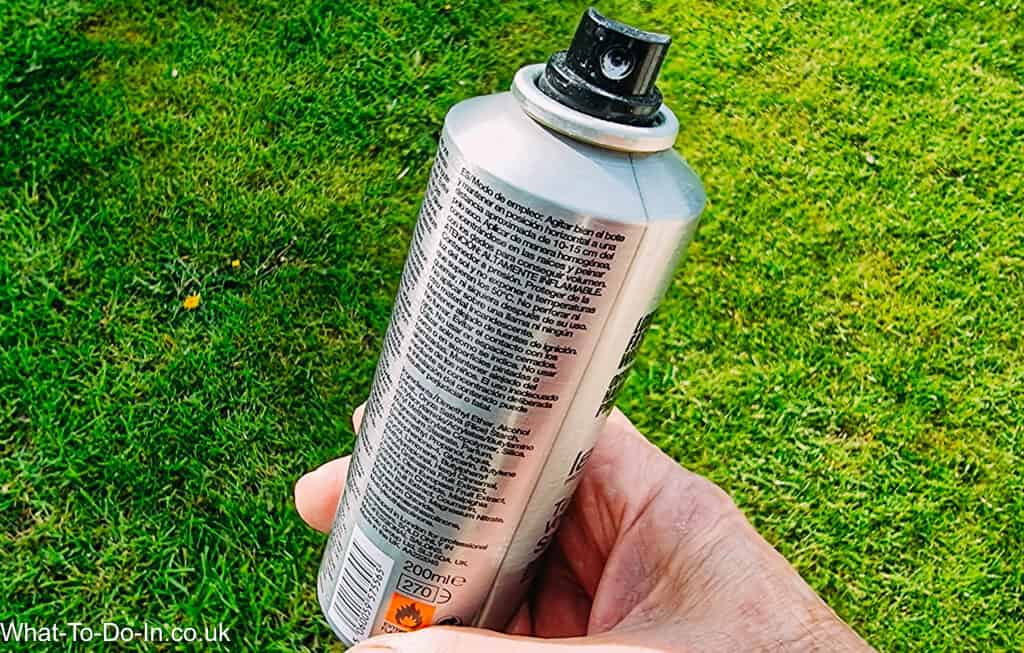
Country-Specific Regulations
Keep in mind that specific countries may have stricter regulations about what can and cannot be brought into the country, including aerosols.
- Australia: Aerosols containing a flammable propellant are not permitted in either checked or carry-on luggage.
- Canada: Most aerosols are permitted in checked luggage, but they are subject to restrictions in carry-on luggage.
- European Union: Aerosols in carry-on luggage must follow the liquid restrictions of 100 ml per item, all fitting into a 1 liter clear plastic bag.
Can you bring aerosols on a plane in Canada?
You can have an aerosol in your carry-on baggage if it is smaller than 100 ml (3.4oz). Aerosols in your checked luggage can only be a maximum of 500 ml or 500 g per container, with a total net quantity not to exceed 2 L or 2 kg per person.
https://www.catsa-acsta.gc.ca/en/what-can-bring/item/liquid-aerosol-or-gel-deodorant
Can you take aerosols on a plane in Europe?
The EU specifies that “mace, pepper sprays, capsicum sprays, tear gas, acid sprays and animal repellent sprays” are not allowed in your cabin baggage.
https://transport.ec.europa.eu/transport-modes/air/aviation-security/information-air-travellers_en
Can you take aerosols on a plane in the UK?
Aerosols are treated in the same way as liquids in the UK. You must have a container that holds no more than 100ml and your containers must be in a single, transparent, resealable plastic bag, which holds no more than a liter and measures approximately 20cm x 20cm.
https://www.gov.uk/hand-luggage-restrictions/personal-items
Can you take aerosols in hand luggage on flights in Australia?
If you are flying in Australia you can not have “aerosol containers, including cans of spray paint” except for “an aerosol container for personal (including cosmetic) use or a medical application (such as an asthma inhaler)”. If you are packing aerosols in your carry-on bags they “must be in containers of 100 ml”. All your aerosols have to fit into “one transparent and re-sealable plastic bag like a snap-lock sandwich bag” and ‘the four sides of the bag’s sealed area must add up to no more than 80 cm”.
https://www.homeaffairs.gov.au/travelsecure-subsite/Pages/Items-you-cannot-take-on-plane.aspx
Can you take aerosols in hand luggage on flights in New Zealand?
When you are traveling in New Zealand, you are allowed allowed “aerosols for medical treatment, and those applied to hair or skin such as deodorant, insect repellent, shaving cream, and hairspray in either your carry-on or check-in bag’. If the aerosol is in your carry-on bag it has to be 100 ml or less but if it is in your checked luggage it can be up to 500 ml. The total quantity of aerosols in your checked suitcase must not exceed 2000 ml.
https://www.aviation.govt.nz/passenger-information/what-can-i-bring/
Can you take aerosols on a plane in Asia?
The guidelines for packing your hand luggage to take on a plane in Asia say “toiletry articles (including aerosols) such as hair sprays, perfumes, medicines containing alcohol, hand sanitizers and alcohol-based disinfectants not exceeding 0.5 liters per article and 2.0 liters in total weight.
https://www.singaporeair.com/en_UK/us/travel-info/baggage/baggage-restrictions/
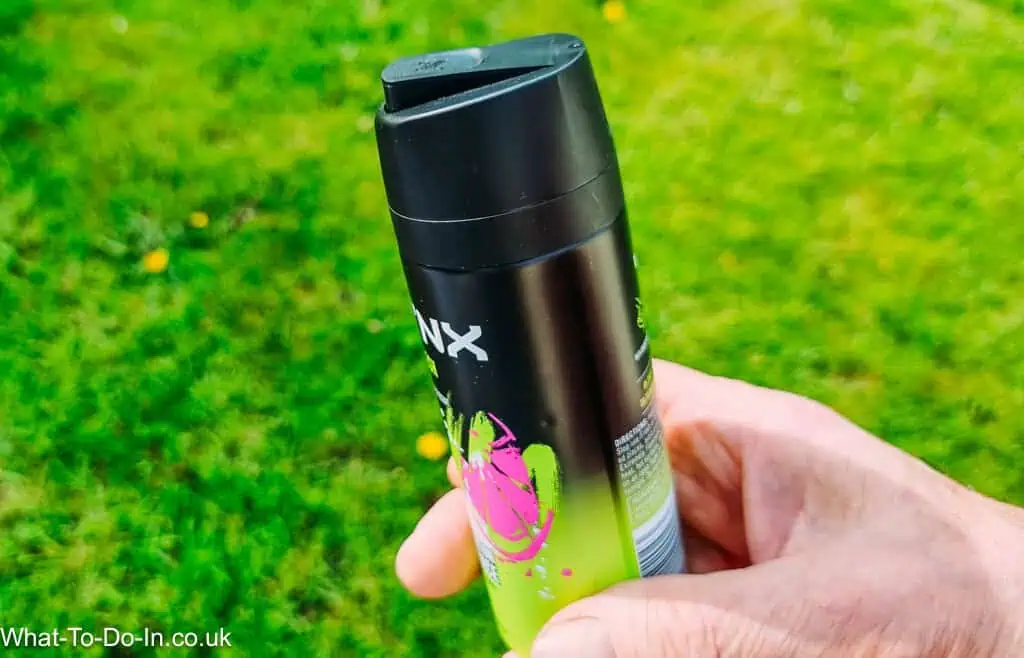
Airline-Specific Regulations
Different airlines may also have specific regulations concerning the transport of aerosols. Always check your airline’s baggage policy before packing aerosols.
- British Airways: Aerosols for sporting or home use are allowed in checked luggage, while toiletries or medicinal aerosols of 100 ml or less are allowed in carry-on luggage.
- Emirates: Aerosols in checked baggage must not exceed 2 kg or 2 liters in total, with no single item exceeding 0.5 kg or 0.5 liters.
- Delta Airlines: Aerosols in carry-on must follow the 3-1-1 liquid rule (Each liquid must be in a 3.4-ounce or less container (“3”), all containers must be placed inside one clear quart-sized plastic bag (“1”), and each passenger is only allowed one plastic bag (“1”)). Aerosols in checked baggage are limited to 70 ounces per passenger.
- Air New Zealand: Only aerosols that are medicinal or toiletry items are allowed in carry-on baggage
While these guidelines can give you a general understanding of the regulations surrounding aerosols on international flights, it’s important to review the specific rules of your airline and your destination country before packing. Always prioritize safety and follow the rules to ensure a smooth and hassle-free journey.
How to Pack Aerosols in Your Luggage
Whether you’re packing deodorant, hairspray, or sunscreen, it’s important to know how to properly pack aerosols for your flight. Most countries and airlines have guidelines requesting you to secure your aerosols so they can’t accidentally spray their contents. This is mainly to protect any customs official who might have to examine your luggage. The last thing you want is for them to get a face full of deodorant or hair-spray! Most aerosols have a cap or a locking device on the trigger. If the cap is loose or if there is no way to secure the trigger it is worth taking a moment to use some tape fix it.
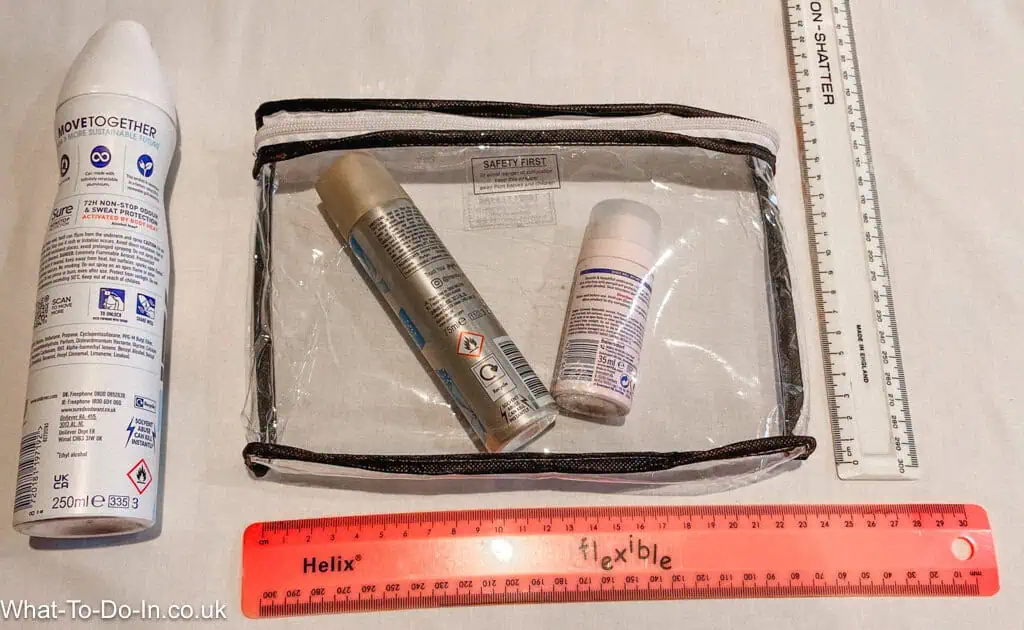
Packing Aerosols in Your Carry-On Luggage
Carrying aerosols in your carry-on luggage requires careful packing due to liquid and size restrictions. Aerosols are classified as liquids. When you go through customs your aerosols have to be taken out of your hand luggage and put in a tray. All your liquids, including aerosols, have to go in a clear plastic bag. You can only have one plastic bag and all of your containers must be 100 ml/3.4 oz or less.
I used to buy the dinky, little travel-sized deodorants for my carry-on bag until I discovered that my body spray comes in a 75 ml aerosol. The travel-sized aerosols are cute but they are very bad value so I felt a bit daft for not realizing earlier! The only liquids I usually have in my hand luggage are deodorant, hand sanitizer, mini toothpaste, and contact lens solution. I can easily fit these into the plastic bag. However, if you travel with more liquid or aerosol items then you may need to get the travel-sized ones so they will all fit in the bag.
I like to use the bag in the photo above and there is usually no problem. However, some countries specify that the clear, plastic bag you use must be 20 cm (7.9 inches) by 20 cm (7.9 inches). As you can see, my bag is 23 cm )9 inches) by 15 cm (6 inches). The only time I have had a problem was coming back from Crete. Even then it wasn’t that big a deal as they just gave a bag and I tipped everything into it.
Bear in mind that some custom officers can be strict about the plastic bags. You can’t use bags that don’t seal closed. Nor will they be happy if the bag is completely clear and see-through. To make things easy we always have all our liquids and aerosols prepacked in the plastic bag. Mine usually fit in the side pocket of my backpack. This means I can simply pull them out and put them in the tray without having to dig through everything in my bag.
- Size Matters: Aerosol cans in your carry-on bag must be 3.4 ounces (100 ml) or smaller.
- Use a Clear Bag: Unlike nail clippers, tweezers, hair dryers, candles, curling irons, all aerosols, along with any other liquids, gels, or creams, should be packed in a single, clear, quart-sized, zip-top bag.
- Packing: Place the aerosol can upright in the bag to reduce the risk of accidental release of the contents.
- Double-Check: Before packing, ensure the aerosol’s cap is secure, and there’s no chance of it accidentally spraying.
Packing Aerosols in Your Hold Luggage
When packing aerosols in your checked (hold) luggage, you have a bit more flexibility, but just as when traveling with trekking poles, safety should still be a priority. You should always make sure that the cap or trigger mechanism is secure. A piece of tape is usually enough to fix any issues. You can’t have anything flammable in an aerosol in your bag. This includes things like spray paint and WD-40 which you might not class as inflammable. This is a precaution in the unlikely event your aerosol explodes.
While we have never had an aerosol explode (thankfully!) we have had one crack and leak. It was a cheap hairspray and it was full and unused. When we opened our suitcase everything was covered in a sticky liquid that we eventually tracked back to the hairspray can. It took us a couple of days to rinse all our clothes but thankfully it was a beach holiday in Fuerteventura so we didn’t really need to wear much more than swimwear.
However, we have learnt from that experience and all our aerosols are in sealed, waterproof bags. We find freezer bags are perfect for this. We then put them in one corner of the suitcase and wrap a towel around them, just to be on the safe side.
- Quantity: In general, you can pack larger quantities of aerosols in checked luggage than in carry-on. However, per passenger, there’s usually a 70-ounce (2 liters) limit.
- Protection: Aerosols should be packed in a way that protects them from being punctured or leaking. Using a padded bag or wrapping them in clothing can provide extra protection.
- Secure the Lid: Make sure the aerosol’s cap is secure and cannot be easily pressed, causing unintentional spraying.
- Flammable Aerosols: Be aware that flammable aerosols, such as spray paint or WD-40, are not allowed in checked luggage.
- Exceptions: Certain aerosols, like self-defense sprays, are often not allowed in either checked or carry-on luggage.
Proper packing of aerosols can help prevent accidents, leaks, and issues with security checks. Always review the guidelines provided by the Transportation Security Administration (TSA) and your specific airline for the most accurate and current information on packing aerosols for your trip.
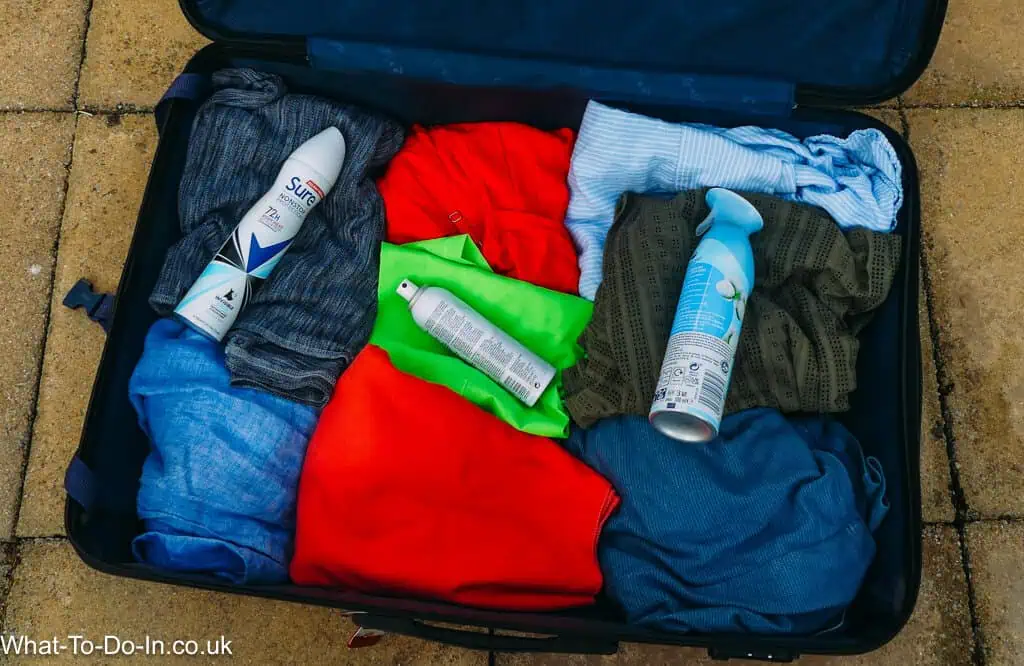
FAQ’s for Taking Aerosol Cans on a Plane
These are the most frequently asked questions about taking aerosols on a plane.
Q: Can I bring aerosols in my carry-on luggage?
A: Yes, you can bring aerosols in your carry-on luggage, but they must be 3.4 ounces (100 ml) or less and must fit in a one-quart-sized, clear, zip-top bag.
Q: Are there size restrictions for aerosols in my checked luggage?
A: There is typically no size restriction for aerosols in checked luggage, but there is a 70 ounces (2 liters) limit per passenger for all aerosols.
Q: Can I bring aerosols like hair spray or deodorant on a plane?
A: Yes, personal care items such as hair spray or deodorant are generally allowed in both carry-on and checked luggage, following the size and quantity restrictions.
Q: Will aerosols explode on a plane?
A: It is very unlikely. Aerosols are pressurized so they are affected by changes in heat and air pressure. Whether they are in the hold or in your cabin luggage, your aerosols are unlikely to be subjected to changes in heat and air pressure extreme enough to make them explode.
Q: Are self-defense aerosols allowed on a plane?
A: No, aerosols like bear sprays, pepper sprays, and tear gas are strictly prohibited from both carry-on and checked luggage.
Q: Can I bring medicinal aerosols on a plane?
A: Yes, medicinal aerosols can usually be carried in both carry-on and checked luggage. They should follow the same size and quantity restrictions.
Q: Are there specific rules for international flights regarding aerosols?
A: Yes, international flights often have similar rules to domestic flights. However, they might vary depending on the airline and the destination country. Always check these specific regulations before your flight.
Q: Can I bring flammable aerosols on a plane?
A: No, flammable aerosols are not allowed on planes due to safety concerns. This includes aerosols such as spray paint.
Q: How should I pack aerosols in my luggage?
A: Aerosols should be packed upright, with the cap securely fastened to prevent accidental discharge. In checked luggage, they should be packed in a way that prevents puncturing.
Q: What happens if I bring an aerosol that is larger than the permitted size?
A: If an aerosol exceeds the permitted size, it will likely be confiscated at the security checkpoint.
Q: Do all airlines follow the same rules regarding aerosols?
A: Most airlines follow similar guidelines, often based on TSA or IATA regulations, but there can be differences. Always check the specific rules of the airline you are flying with.
Packing Up – Flying With Aerosols
In conclusion, taking aerosols on a plane is entirely possible but there are specific rules and regulations. For carry-on luggage, aerosols must be 3.4 ounces (100 ml) or less. They must fit in a single, clear, quart-sized, zip-top bag along with any other liquids. The rules for hold luggage or checked baggage allow for larger aerosols, though there’s typically a total limit of 70 ounces (2 liters) per passenger. It’s also important to remember that certain aerosols, such as flammable ones or self-defense sprays, are usually prohibited.
The regulations can vary depending on the airline and the country. Therefore, it’s always wise to check the specific rules before your flight. We almost got caught by this as we usually take mosquito spray in our hold luggage. However, the airline we were flying to Thailand with didn’t allow insect repellents designed to be sprayed in the air. Thankfully, Aidan double-checked the airline’s guidelines before we left. Traveling with aerosols is simple and straightforward as long as you check the regulations.




